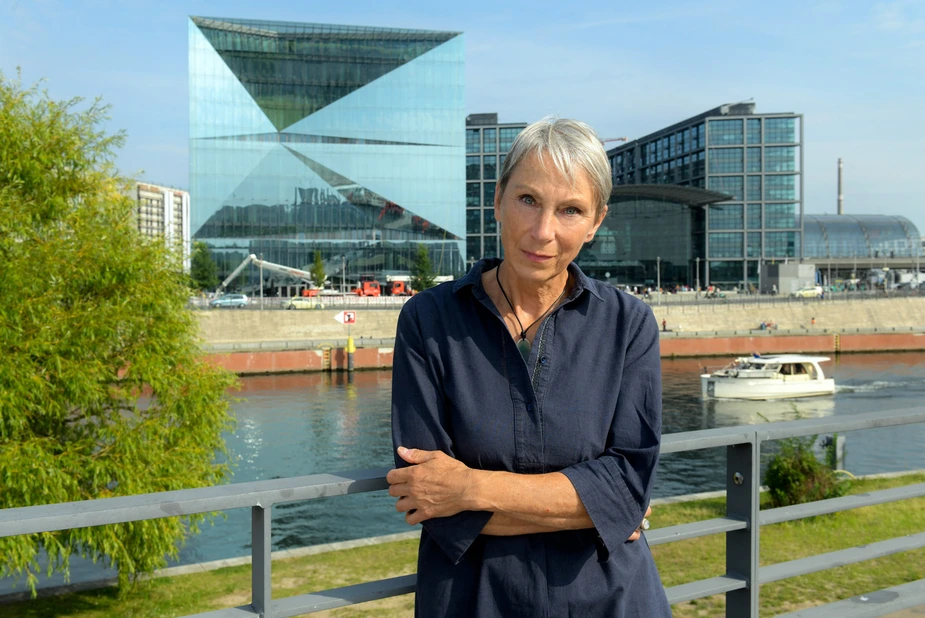The minus sign represents something positive
In conversation with Beate Mekiffer, who coordinates innovation projects at WISTA Management GmbH
To Beate Mekiffer, the minus sign represents something positive. For eleven years now, WISTA Management GmbH’s energy expert has been working on making the high-tech site Adlershof more energy efficient. She does so on the basis of an integrated energy concept that she developed together with her team. Its aim is to ensure a 30 percent reduction in primary energy consumption for the growing Science City by the time its full capacity has been reached. Potential for savings go beyond electricity to include heating, cooling, and transportation. With a PhD in geology, Mekiffer previously worked at the Institute for Chemical Technology of the Academy of the Sciences in Adlershof and, later, at the ecology research department of Technical University Berlin. Her know-how is now being channelled into other technology sites in Berlin such as the first-ever electricity-only technology quarter—FUBIC in Dahlem. She recharges her own batteries while trekking through Brandenburg’s gravel quarries searching for very old rocks.
Adlershof Journal: What is your job at WISTA?
Beate Mekiffer: My team and I realise projects for more energy efficiency, sustainable mobility, and smart cities as well as projects on the interface of those topics. It is important to me to bring innovation and sustainability together, and make ecology and economics more compatible.
Where do you currently see energy efficiency potential?
Potential for savings lies in buildings, especially existing ones. Which is why we took a close look at each of WISTA’s technology building and identified a range of measures. This includes, for example, an individual and needs-based user heating programme for our company headquarters on Rudower Chaussee 17. It will be launched for this year's heating season. Instead of a centralised standard heating programme, it will now use digital controls for every room.
How does it pay off and how do you motivate users?
The expected energy savings are between ten to 15 percent. Users receive information on how energy-efficient they are. That will certainly encourage them to avoid unnecessary heating costs. In addition, the technology that we developed and installed for this project will serve as a blueprint for the FUBIC innovation centre.
Speaking of FUBIC. What were the challenges working on this electricity-only project?
It’s a very interesting and diverse project, which I’ve been working on since 2016: the first-ever electricity-only technology district. Since we are entering unchartered territory, we had to and continue to overcome numerous hurdles and win over many sceptics. The legal framework hasn’t been created for what we are doing and needs to be adapted to it. We will also have to turn on some screws regarding feasibility. In contrast, the technical implementation of sector coupling, i.e., using renewable electricity to generate heat, cooling and drive energy, is not a problem.
When technology districts become carbon-neutral, aspects of mobility also play a role. Which topics are your focus here?
Adlershof has its own mobility concept that deals primarily with passenger transportation. In the future, we expect transporting goods to be given more weight—by that I mean, creating possibilities for companies to make their movement of goods more sustainable. Self-driving electric vehicles could help here. Some will know the self-driving shuttle busses from the EUREF campus. They can do it because it’s private property. In the short term, we want to shed light on the requirements that must be realise self-driving shuttles at Adlershof Technology Park.
Do you live sustainably?
I’m not big on heating, save energy whenever I can, take public transport to work, and buy regional products. I have a large garden in the Uckermark, in the north-east of Brandenburg, where I have a meadow orchard with ancient fruit.
What do you do in your spare time?
Stones are my passion. Holding a 500-million-year-old stone in my hand fascinates me and puts a lot of things into perspective. I drive to gravel quarries, collect so-called Nordische Geschiebe and agate, and work them with a stone saw and a sanding machine. I also volunteer at the association Friends of Mineralogy and Geology e. V. (VFMG), where I prepare exhibitions, but I am also helping a gravel pit owner to create a bed load garden. Lastly, I spend as much time as possible with my six grandchildren.
What else is on your wish list?
Two travel destinations: Iran, because it's an incredibly interesting country historically and I've read so much about the local hospitality, and Bolivia, because my father worked there for a while and my son-in-law was born there.
Von Sylvia Nitschke für Adlershof Journal
